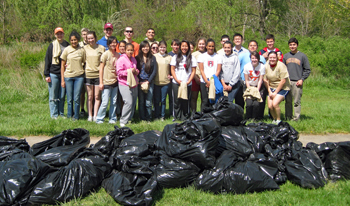
Alert:


 The Invasive Management Area (IMA) Volunteer Program is a community project that aims to reduce invasive plants in our parks. Through IMA, you will help protect the native plants and wildlife of Fairfax County’s natural areas. You will spend time outdoors, meet new people and help heal native habitats.
The Invasive Management Area (IMA) Volunteer Program is a community project that aims to reduce invasive plants in our parks. Through IMA, you will help protect the native plants and wildlife of Fairfax County’s natural areas. You will spend time outdoors, meet new people and help heal native habitats.
“For me, IMA is about people of all socio-demographic backgrounds who share a passion for volunteering to protect Fairfax County parks.”
Invasive plants are non-native species that were introduced on purpose or by accident from other regions of the world, or the country. Invasive plants can tolerate a range of habitats and grow almost anywhere. For example, Japanese Stiltgrass, Microstegium vimineum, can produce seed in as little as 1% sunlight. Invasive plants often produce huge amounts of seed or have roots that spread aggressively. They compete with native species for nutrients, sunlight and water, eventually reducing native populations.In some cases, they can even eliminate a native species from a community altogether.
Some invasive plants have more complicated effects on the food chain that lead to fewer native birds and less wildlife. Invasive plants are linked to the decline of the songbird population because scientists have found that the berries of invasive shrubs are “junk food” for birds. They are also tied to the potential extinction of other species. For example, the West Virginia white butterfly is threatened because the butterflies confuse their native host plant with invasive Garlic Mustard, and eggs laid on Garlic Mustard cannot survive.


The IMA project started in 2006 with 20 site leaders. Since then, more than 150 acres have come under IMA management, and there are now 65 sites and 75 IMA site leaders across the county. Find your closest site and make an impact!
Click Infographic and Map to enlarge


Invasive Management Area funding is provided by the Fairfax County Board of Supervisors in support of the board’s Environmental Agenda. In 2025, the Park Authority, a core member of the National Capital - Partnership for Regional Invasive Species Management (Nat-Cap PRISM) received a grant from the Virginia Department of Forestry to support the invasive species program. The IMA program also is supported in part by the Fairfax County Park Foundation.
To learn how private and corporate donations help restore parkland habitat, please visit the Park Foundation website.
Help restore Fairfax County’s natural areas one plant at a time! The IMA Program empowers volunteers to protect native habitats and remove invasive species through hands-on conservation and community leadership. Join the IMA community and select one of these rewarding volunteer opportunities to help restore our parks.
Tier 1: Tree Rescuer
Tier 2: IMA Volunteer/Steward
Tier 3: IMA Site Leader
Tier 4: IMA Trainer/Supervisor

Find and slow the spread of newly arrived invasives through the Early Detection and Rapid Response program.
View this StoryMap created by two IMA Site Leaders using GIS (Geographic Information Systems) to learn more about how the IMA Program works.
We thank our many partners for their continued support of IMA.
